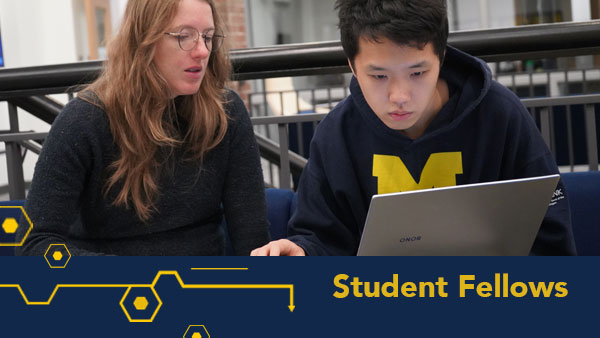Amy Homkes-Hayes, Lead Innovation Advocate
What happens when you bring together students from diverse disciplines like public health, law, and information to tackle a real-world medical policy and regulation challenge? Turns out great ideas emerge from multidisciplinary teams working under a tight timeframe (just 4 hours) on a pressing design challenge. Recently, the Office of Academic Innovation partnered with the U-M School of Public Health, School of Information, and Law School to host a multidisciplinary student design jam.
Students were put into interdisciplinary teams to ensure a diverse and well-rounded approach to tackling our design challenge. Speaking of design challenges, our event served to be both timely and relevant in partnering with Michigan Medicine faculty Jodyn Platt, MPH, Ph.D. and the Michigan Health Information Network Shared Services (MiHIN), a State of Michigan non-profit organization focused on how health information is exchanged both within and beyond states throughout the U.S. As Professor Platt and her MiHIN colleagues explained, some states opt into sharing health information, while others opt out. Relatedly, currently there is no effective infrastructure for hospitals, clinics, and other patient serving entities to easily, efficiently, and securely share health records between them. As a result, most often hospitals rely on more labor and time intensive methods like fax to share records. As people like Professor Platt and organizations like MiHIN grapple with these challenges, designing better systems for granting permission to and share health data are timely.
Professor Platt and MiHIN challenged our teams to create a tool or a policy that effectively helped manage the sharing of health records and data within and beyond the State of Michigan. Our students quickly responded to the challenge and delved thoroughly into the five major steps of the design thinking process:
Iteration: Our teams brainstormed lots of ideas in response to the design challenge first as individuals, and then as groups. They grappled with questions on how existing, and highly variable, state laws and regulations informed their design process. They communicated with one another across difference as they clarified ideas and refined ideas.
Prototyping: Once our teams settled on an idea or framework they started prototyping designs. Some of our teams envisioned creating a system for patients and healthcare providers to access and update permissions for sharing health data. Others thought about existing healthcare infrastructure like medical records systems, insurance systems, and others to add permissions and information to. Student teams received feedback and guidance from Digital Innovation Greenhouse full-time user experience, behavioral science, and data science staff on things to consider and ways to build mock-ups and wireframes.
User Feedback and Prototyping (again): Each team met with with Professor Platt, her PhD student, Gracie Trinidad, and MiHIN leadership to get feedback and implement on their prototypes.
Pitch: Student teams were given four minutes each to pitch their final prototypes to Professor Platt and MiHIN. As you can imagine four minutes is not a lot of time to thoroughly explain your process and product, however our student teams did a great job of crafting concise presentations on their prototypes and their competitive advantages.
In the end, both Professor Platt and MiHIN indicated they were thoroughly impressed with the thoughtfulness, intelligence, and overall responsiveness of each design. Professor Platt and MiHIN also offered the winning student team the opportunity to present their prototype at the Michigan Medicine sponsored Ethical, Legal, and Social Implications of Learning Health Systems Symposium on November 14th, 2017, and both Professor Platt and MiHIN indicated a sincere interest in continuing to work with the winning team on their idea. Events like these demonstrate the value of tackling complex challenges relying on various backgrounds, experiences, identities, and skill sets.
As students indicated as they left for the evening, they appreciated learning from and being partners with students from other schools who they would otherwise may have never met. They remarked at how worthwhile it was to iterate for a real client with a pressing problem where their designs may make a real impact, and where they were able to deeply engage researchers and professionals dealing with these exact same problems in the field.


